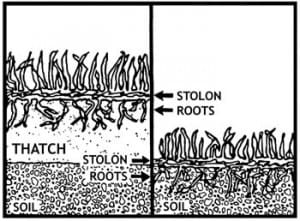Source(s): Gil Landry, PhD., Coordinator- The Center for Urban Agriculture, The University of Georgia.
Thatch is defined as an accumulation of dead and living plant material (stems, roots, and shoots) that develops between the soil surface and the green leaves of a turf. Thatch development is a natural process that occurs during normal growth of turfgrasses. Although some thatch is desirable, thatch becomes undesirable when it exceeds a depth of 1/2 inch.

Examine thatch depth by using a knife, spade, or soil probe to remove a small section of turf (soil included). If the thatch layer is thicker than 1/2 inch, dethatching is needed. Remember that thatch buildup is gradual and occurs over a period of years. Therefore, it’s logical that a thatch removal program should also be gradual.
The following cultural practices are effective methods of thatch removal:
- Topdressing once or twice a year with a 1/4 inch layer of topsoil is the most effective method of thatch reduction. This practice increases the thatch decomposition rate. Heavier applications of topsoil may cause layering, which restricts water, air and fertilizer movement in the soil. However, a top-dressing is also the least practical cultural practice because of the cost of specialized equipment, top-soil and labor. Topdressing can also be a source of weed seed.
- Vertical mowing is the most common method of thatch removal. This specialized mower has evenly spaced blades that revolve perpendicularly to the turf and slice into the thatch to mechanically remove it. It is very important to use proper blade spacing when vertically mowing different turfgrasses. Use a blade spacing of 1 to 2 inches for bermudagrass and zoysiagrass, 2 to 3 inches for centipedegrass, and 3 inches for St. Augustinegrass. Bermudagrass may be mowed down to the soil level in several directions without killing the lawn because of underground rhizomes. Centipedegrass and St. Augustinegrass should only be vertical mowed in one direction to avoid removing too much plant material and reducing the rate of recovery. If a thatch layer exceeds 1/2 inch depth, the turf area should be carefully vertically mowed and allowed to recover between mowings. Vertical mowing is best done in the spring after greenup where the grass is growing rapidly and when the weather is not so hot that turf water needs are high. Another good time to vertical mow is in early spring just before greenup occurs.
- Power raking uses the same mechanical principles as vertical mowing. Flexible, spring steel wires revolve at high speed vertically through the turf and loosens the debris for removal. Power raking can be useful for loosening debris, but it is not as effective as vertical mowing.
- Scalping is a poor substitute for vertical mowing, but its use, especially in early spring may delay the need for vertical mowing where build up is minimal. Scalping is a procedure in which the turf is mowed at a much lower height than normal. Scalping heights will vary with turfgrass species. Turfgrasses with rhizomes, like bermudagrass and zoysiagrass, may be scalped down to near the soil surface. Centipedegrass and St. Augustinegrass spread by above-ground runners called stolons. Removing these stolons would kill the turf. Zoysiagrass is not as sensitive to scalping as centipede and St. Augustine, but it is more sensitive than bermuda. Scalping below the crown or green growing points of zoysia will cause excessive damage.
- Core aeration benefits thatch decomposition primarily through the indirect effects that stimulate bacterial activity. Core aeration also relieves soil compaction and increases air and water movement into the soil. This is best accomplished by a power aerator that has hollow tines or spoons, so it removes a soil core 2 to 3 inches deep and 1/2 to 3/4 of an inch in diameter. Core aeration should be done during periods of active plant growth and when the soil is moist enough to allow deep penetration. Applying a fertilizer as recommended by soil analysis after a cultural practice will increase the rate of turf recovery.
Resource(s):
Center Publication Number: 139
- Grasscycling: Feed Your Landscape, Not the Landfill - September 24, 2013
- Fertilizing Lawns - September 24, 2013
- Mowing Lawns - September 24, 2013